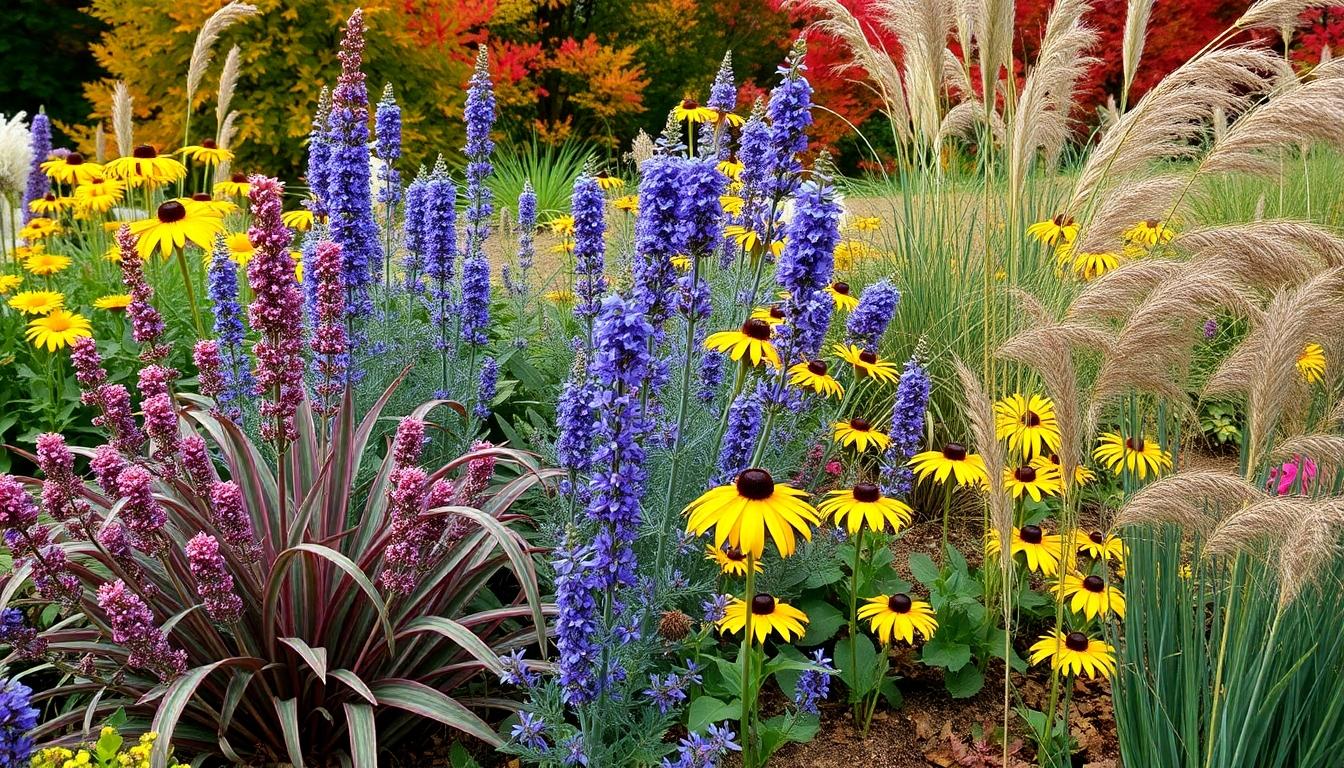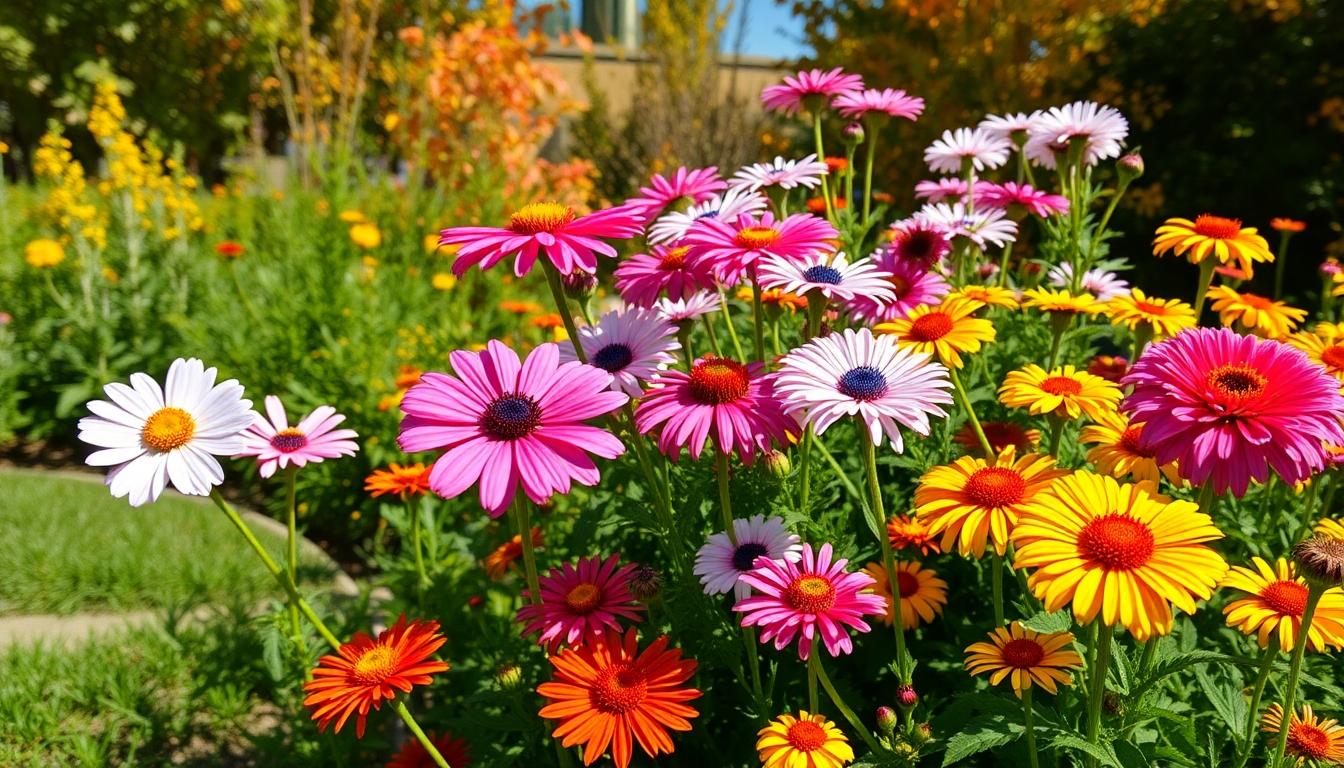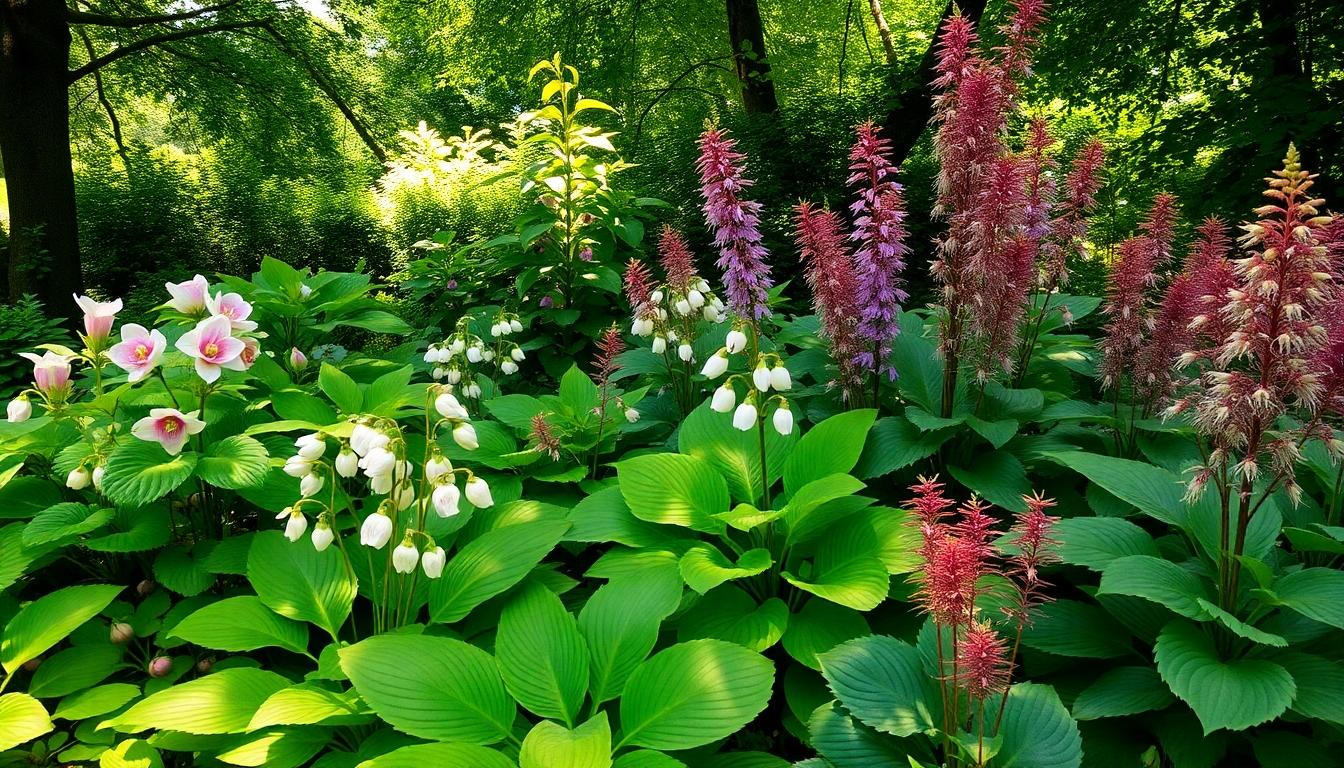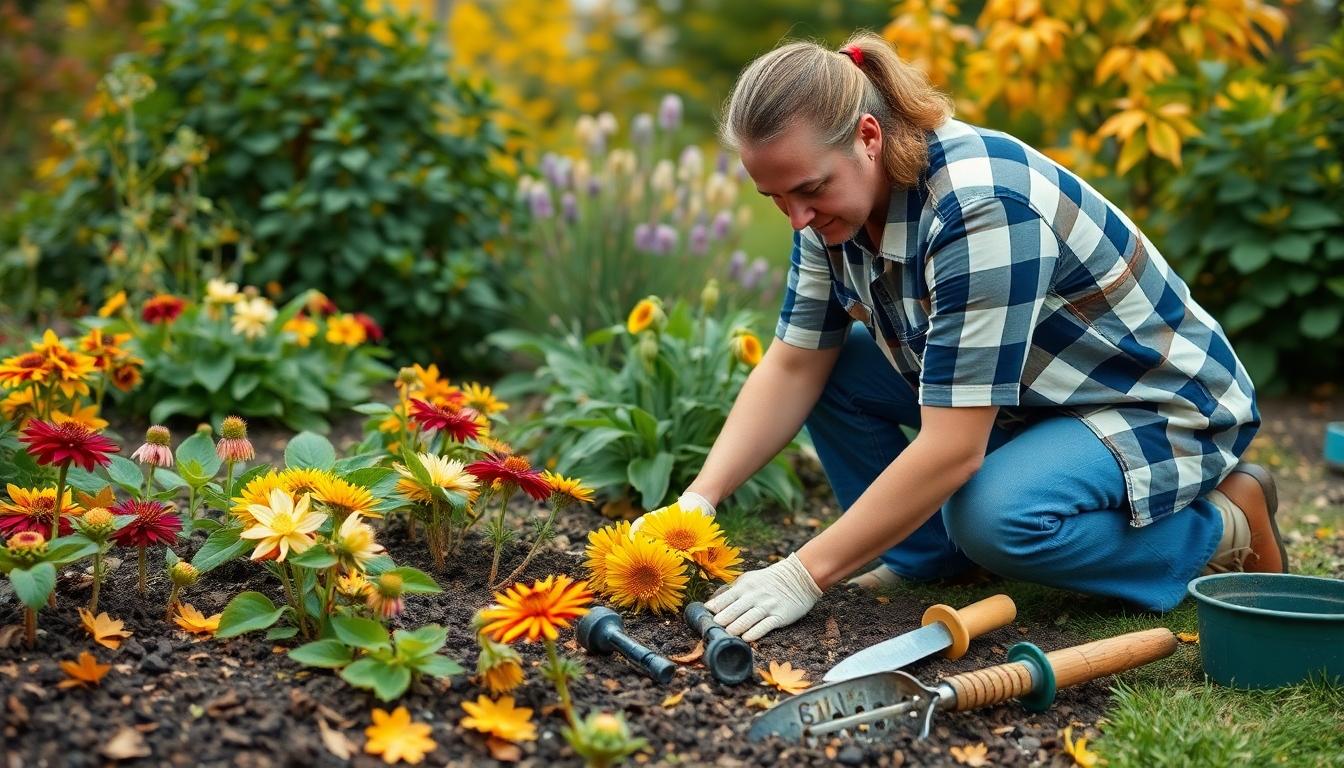Fall isn’t just about cozy sweaters and pumpkin spice—it’s also an ideal time to plant perennials that’ll reward you with years of beauty. While many gardeners hang up their tools after summer, we’re here to tell you that autumn’s cooler temperatures and reliable rainfall create perfect conditions for establishing root systems before winter sets in.
Why Fall Is the Perfect Time to Plant Perennials
Fall presents an ideal window for establishing perennials in your garden, offering several advantages over spring planting. Cooler air temperatures combined with still-warm soil creates the perfect environment for root development without the stress of summer heat. Plants experience less transplant shock during autumn months, allowing them to focus energy on developing strong root systems rather than struggling to produce flowers or foliage.
Rainfall patterns typically become more reliable in fall, providing consistent moisture that new plantings need without the excessive watering summer gardens often require. Soil conditions improve as well, with earth that’s easier to work after summer’s heat has passed. Many garden pests and diseases naturally decline as temperatures drop, giving your new perennials a fighting chance to establish themselves without these additional stressors.
Nurseries and garden centers frequently offer end-of-season sales during fall months, making it economically smart to shop for perennials during this time. These plants will have all winter to establish their root systems, resulting in stronger, more vigorous growth when spring arrives. Your fall-planted perennials will typically outperform their spring-planted counterparts in terms of size, flowering, and overall health during the following growing season.
The extended establishment period gives perennials a important head start, enabling them to better withstand next summer’s heat and potential drought conditions. Fall planting essentially provides your perennials with an extra growing season before they face their first summer challenge. We’ve found that this timing advantage translates to more resilient plants that require less maintenance and provide greater visual impact in their first full display season.
10 Cold-Hardy Perennials to Plant This Fall

Fall is the perfect time to add these resilient perennials to your garden. These cold-hardy varieties will establish strong root systems before winter and reward you with beautiful blooms next season.
Sedum (Stonecrop)
Sedum stands out as an exceptionally cold-hardy perennial that thrives in zones 3-9. Its succulent leaves store water, making it drought-tolerant once established. Sedums offer varying heights, colors, and textures that add interest to fall gardens. Plants like ‘Autumn Joy’ produce stunning flower heads that transition from pink to copper as the season progresses.
Russian Sage
Russian Sage delivers striking silvery-gray foliage that creates a beautiful backdrop for other fall plants. This drought-tolerant perennial flourishes in zones 3-8 without much maintenance. Its lavender-blue flower spikes attract pollinators while adding vertical interest to your garden design. Russian Sage pairs exceptionally well with warm-colored perennials for a striking contrast in your fall industry.
Echinacea (Coneflower)
Echinacea captivates with its vibrant flowers and impressive resilience in zones 4-9. These native prairie plants develop deep root systems during fall planting, resulting in stronger spring growth. Coneflowers attract beneficial pollinators including butterflies and bees throughout their long blooming period. Their distinctive seed heads provide visual interest well into winter, offering food for birds when other sources become scarce.
Black-Eyed Susan
Black-Eyed Susan brightens gardens with cheerful daisy-like yellow flowers and distinctive dark centers. Hardy in zones 4-9, these reliable perennials establish quickly when planted in fall. They naturalize readily, creating drifts of color that return year after year with minimal care. Black-Eyed Susans bloom abundantly from midsummer through fall, providing continuous color when many other perennials have finished flowering.
Ornamental Grasses
Ornamental grasses offer excellent cold hardiness and bring diverse textures to the fall garden. Many varieties thrive in zones 4-9, providing year-round interest through changing seasons. Grasses create movement and sound as they sway in autumn breezes, adding a ever-changing element to static plantings. Their feathery plumes catch morning frost in winter, transforming ordinary garden beds into magical landscapes during the coldest months.
5 Flowering Perennials That Bloom in Fall and Beyond

While many gardens begin to fade in autumn, these five perennials bring spectacular color and interest well into the fall season.
Japanese Anemone
Japanese Anemone stands out as an exceptional late-season bloomer, producing elegant white or pink flowers from late summer through early fall. These graceful perennials prefer growing in partial shade conditions where they can receive morning sun but avoid intense afternoon heat. Their delicate, windflower-like blooms sway on tall stems above attractive foliage, creating movement in the autumn garden. For best results, plant Japanese Anemone in consistently moist, well-draining soil where it can establish a strong root system before winter arrives.
Aster
Asters burst into a spectacular display of pink, purple, and white blooms just when most other perennials have finished flowering. These fall-flowering stars attract many butterflies and pollinators, adding both color and ecological value to autumn landscapes. They perform best in full sun locations with moderate moisture, though many varieties tolerate a range of conditions. Their daisy-like flowers create a sea of color that pairs beautifully with ornamental grasses and other fall bloomers. Consider planting several aster varieties for an extended bloom season that carries your garden through the entire fall.
Chrysanthemum
Chrysanthemums offer the quintessential fall garden experience with their vibrant blooms in rich shades of yellow, orange, red, and purple. These popular perennials thrive in sunny spots with well-draining soil, rewarding gardeners with prolific flowering during autumn months. Their diverse flower forms range from button-like pompoms to daisy shapes, providing texture and dimension to seasonal displays. Fall planting allows chrysanthemums to establish strong root systems, increasing their chances of winter survival and ensuring more abundant blooms in subsequent years.
Helenium
Helenium contributes bright splashes of warm color to the fall garden with its daisy-like flowers in copper, gold, and mahogany tones. These sturdy perennials prefer full sun exposure and perform exceptionally well in dry soil conditions once established. Their distinctive blooms feature prominent centers with colorful ray petals that attract beneficial insects to the garden. Plant Helenium alongside ornamental grasses and asters for a stunning autumn display that maintains visual interest well into the season. Their upright growth habit makes them perfect for back borders where they can rise above shorter fall bloomers.
Goldenrod
Goldenrod delivers spectacular golden-yellow flower plumes that illuminate the autumn industry while supporting many pollinators. Contrary to common misconception, these valuable fall bloomers don’t cause allergies (ragweed is the actual culprit) and deserve a place in ecological gardens. These adaptable plants thrive in diverse conditions from dry to moist soils, making them suitable for various garden settings. Their bright yellow flowers create dramatic contrast with purple asters and burgundy ornamental grasses. Plant goldenrod in naturalistic settings where it can form impressive drifts that glow in the slanting fall sunlight.
4 Shade-Loving Perennials for Fall Planting

Not every garden basks in full sunlight, which is why we’ve curated this list of shade-tolerant perennials that thrive when planted in fall. These varieties establish strong root systems during cooler temperatures, ensuring beautiful displays in the coming seasons.
Hellebore
Hellebores, often called Christmas roses, perform exceptionally well when planted in fall’s cooler conditions. These elegant perennials bloom in late winter to early spring, providing much-needed color when most gardens remain dormant. Their preference for shady conditions makes them perfect for woodland gardens or areas beneath deciduous trees. Hellebores feature leathery, evergreen foliage that adds year-round interest and produces cup-shaped flowers in shades of white, pink, purple, and green that last for months.
Bleeding Heart
Bleeding Heart plants charm gardeners with their distinctive heart-shaped flowers that dangle from arching stems. Fall planting gives these shade-loving perennials ample time to establish before their spring flowering period. Their delicate pink or white blooms add a romantic, cottage-garden feel to shaded spots. Bleeding Hearts prefer rich, moist soil with good drainage and perform best in partial to full shade environments. These plants typically go dormant in summer heat, making them excellent companions for late-emerging perennials.
Hosta
Hostas reign supreme in the shade garden industry thanks to their impressive foliage and easy-growing nature. Fall offers an ideal planting window for these versatile perennials, allowing their roots to settle before winter dormancy. Their large, textured leaves come in countless variations of green, blue, gold, and variegated patterns. Hostas thrive in deep shade conditions where many other plants struggle. Most varieties produce attractive flower spikes in summer, but gardeners primarily value them for their spectacular foliage that creates structure and visual interest throughout the growing season.
Astilbe
Astilbe brings dramatic plumes of feathery flowers to shaded garden areas when planted in fall. These reliable perennials prefer moist, shady locations and reward gardeners with striking blooms in shades of pink, red, lavender, and white. Their fern-like foliage provides attractive texture even when not in flower. Astilbes work beautifully in rain gardens or along shaded water features where their moisture requirements are naturally met. Their ability to thrive in areas with minimal sunlight makes them valuable additions to woodland gardens or north-facing beds where options are often limited.
Essential Tips for Fall Perennial Planting Success

Successfully establishing perennials in fall requires attention to several key factors. Follow these essential guidelines to ensure your fall-planted perennials thrive and return with vigor next season.
Proper Timing for Your Region
Timing your fall planting correctly is crucial for success. Plants need 6-8 weeks before the first hard frost to establish their root systems properly. For gardeners in colder zones (3-5), we recommend planting during September and October to give plants adequate establishment time. Those in warmer zones (6-9) can continue planting into November with good results. Focus on hardy varieties like Hellebore (Zones 4-9), Coneflower (Zones 3-9), and Salvia (Zones 5-9) that reliably withstand winter conditions after fall planting. Understanding your exact hardiness zone helps determine the ideal planting window for successful perennial establishment.
Soil Preparation Techniques
Proper soil preparation creates the foundation for healthy perennials. Incorporate compost or organic matter into your planting area to improve both drainage and fertility. Adding coarse sand or perlite to heavy clay soil helps prevent waterlogging, which can be fatal to new plantings. Test your soil’s pH and adjust to 6.0-7.0 for most perennials, though some varieties like Gaillardia tolerate slightly alkaline conditions. Avoid using high-nitrogen fertilizers in fall plantings as they can stimulate tender new growth that won’t have time to harden off before winter. Focus instead on improving soil structure and providing balanced nutrients that support root development rather than leaf growth.
Watering Guidelines for Fall Plantings
Water management is critical for establishing fall perennials. Immediately after planting, water deeply to eliminate air pockets around the roots. Continue providing consistent moisture (about 1 inch weekly) until the ground freezes. Plants like Russian Sage (Zones 4-9) and Sedum (Zones 3-9) require less frequent watering due to their drought-tolerant nature. Apply 2-3 inches of shredded bark or straw mulch around new plantings to retain soil moisture and regulate temperature fluctuations. Mulch creates an insulating layer that protects developing root systems from freeze-thaw cycles that can damage or kill new plantings. Monitor soil moisture regularly, as fall conditions can sometimes be deceptively dry even though cooler temperatures.
How to Prepare Your New Perennials for Winter

After planting your fall perennials, it’s crucial to prepare them for the upcoming cold months to ensure they emerge strong and healthy in spring. We’ve compiled essential winterizing steps that will protect your new garden investments through the harsh winter conditions.
1. Provide Thorough Hydration
Water your perennials deeply before the ground freezes to prevent winter desiccation. Plants can’t absorb moisture from frozen soil, so this final drink helps them survive dry winter winds. Continue watering until temperatures consistently drop below freezing.
2. Apply Protective Mulch
Spread 2-3 inches of mulch around the base of your perennials after the ground begins to freeze. Shredded bark or straw works exceptionally well as insulation for the root systems. Always keep mulch slightly away from stems to prevent rot and rodent damage during winter months.
3. Trim Back Dead Foliage
Cut back the foliage of most perennials after frost has blackened the leaves. This practice reduces disease issues and creates a tidier garden appearance. Evergreen perennials like Adam’s Needle Yucca, with its striking powdery blue foliage (hardy in Zones 5-10), should be left intact throughout winter.
4. Install Pest Barriers
Protect your investment from hungry wildlife by surrounding valuable specimens with chicken wire or protective mesh. Rabbits and deer become particularly active in winter when food sources are scarce, and your newly planted perennials make tempting targets.
5. Hold Off on Fertilizing
Avoid applying fertilizer to fall-planted perennials before winter. Fertilizer stimulates vulnerable new growth that won’t have time to harden off before freezing temperatures arrive. Wait until spring to provide nutrients for your established plants.
6. Consider Special Care Requirements
Different perennials may need exact winter protection. Garden Candy Peonies (Zones 3-8a) require careful planting depth with buds positioned 1-2 inches below soil level to prevent frost heave. Ironweed (Zones 4-9) needs no pruning before winter, as its sturdy stems provide valuable structure and visual interest throughout the dormant season.
By following these winter preparation steps, we’ll ensure our fall-planted perennials not only survive but thrive when warmer weather returns. These simple protective measures significantly increase the chances of a spectacular display in next year’s garden.
Long-Term Care for Fall-Planted Perennials
Fall planting gives your perennials a head start for next year’s garden. With proper care and the right plant selection your autumn garden investments will reward you for years to come.
By choosing hardy varieties like Sedum and Echinacea alongside shade-lovers such as Hellebores and Hostas you’re creating a diverse industry that performs across seasons. Remember that winterizing isn’t the end but rather preparation for the vibrant growth cycle ahead.
We’ve shared our favorite fall perennials and essential planting tips to help you make the most of this ideal planting season. Now it’s time to grab your gardening tools and take advantage of cooler temperatures favorable soil conditions and those end-of-season nursery sales. Your future garden will thank you!
Frequently Asked Questions
Why is fall a good time to plant perennials?
Fall offers ideal conditions for establishing strong root systems due to cooler temperatures and consistent rainfall. Plants experience less transplant shock, soil conditions are improved, and many nurseries offer end-of-season sales. Fall-planted perennials develop stronger roots over winter, leading to better growth and drought resistance the following summer.
What are some cold-hardy perennials for fall planting?
Excellent cold-hardy perennials include Sedum, Russian Sage, Echinacea, Black-Eyed Susan, and ornamental grasses. These varieties establish strong root systems before winter arrives. Sedum offers drought tolerance with diverse colors, Russian Sage attracts pollinators, Echinacea develops deep roots, Black-Eyed Susan requires minimal care, and ornamental grasses add texture and movement year-round.
Which perennials will bloom in the fall season?
Fall-blooming perennials include Japanese Anemone, Aster, Chrysanthemum, Helenium, and Goldenrod. Japanese Anemone produces elegant blooms in partial shade, Asters display vibrant colors that attract pollinators, Chrysanthemums offer rich colors in sunny locations, Helenium adds warm tones, and Goldenrod features striking yellow plumes supporting beneficial insects.
What perennials work well in shaded areas?
Shade-loving perennials suitable for fall planting include Hellebore, Bleeding Heart, Hosta, and Astilbe. Hellebores bloom in late winter, adding color to shaded areas. Bleeding Hearts feature distinctive heart-shaped flowers in rich, moist soil. Hostas are valued for impressive foliage in deep shade, while Astilbe offers feathery blooms in moist, shady locations.
When should I plant perennials in the fall?
Plant perennials 6-8 weeks before the first hard frost in your area. This timing varies by hardiness zone but generally means September through early November, depending on your location. This gives plants adequate time to establish roots before winter without encouraging too much vulnerable new growth.
How do I prepare soil for fall perennial planting?
Prepare soil by removing weeds and incorporating 2-3 inches of compost or aged manure. Test soil pH and adjust as needed for specific plants. Loosen compacted soil to a depth of 12-15 inches to encourage root development. Well-prepared soil provides essential nutrients and proper drainage for establishing perennials.
Do fall-planted perennials need special watering?
Yes, consistent watering is crucial for fall-planted perennials. Water deeply immediately after planting and maintain moisture until the ground freezes. Once established, reduce frequency but increase depth. A soaker hose works well by delivering water directly to roots while keeping foliage dry to prevent disease.
How should I prepare perennials for winter?
Prepare perennials for winter by thoroughly watering before the ground freezes, applying 2-3 inches of protective mulch after the ground freezes, trimming back dead foliage on certain varieties, installing pest barriers against wildlife damage, and avoiding fertilization. Different perennials may have specific care requirements, so research your particular varieties.
Should I prune all perennials before winter?
No, not all perennials should be pruned before winter. Some varieties benefit from keeping their foliage for protection, while others should be cut back. Generally, diseased foliage should be removed, but seed heads can provide food for birds and winter interest. Specific varieties like Ironweed should remain unpruned through winter.
Are there economic benefits to fall perennial planting?
Yes, fall perennial planting offers significant economic benefits. Many nurseries hold end-of-season sales with discounts of 30-50% on healthy plants. Fall-planted perennials typically develop stronger root systems, resulting in more vigorous growth the following year and potentially reducing replacement costs from summer planting failures.







